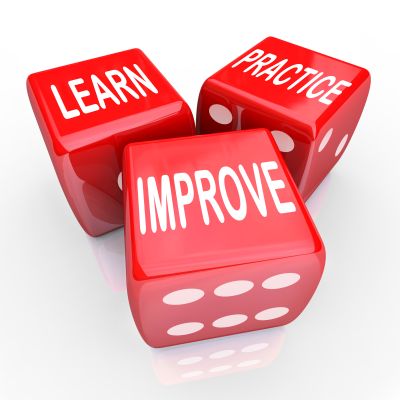
Poker, golf and tennis have a lot in common.
For beginners, they are all skill games. Even a hole-in-one for a golfer, which can be compared to being struck by a lightening bolt out of a cloudless sky, has its counterpart in poker, which would be a royal flush.

The longer you practice playing golf or tennis, the better your game should become. I once asked Doyle Brunson, who is king of winning the World Series of Poker, how many years it would take me to become a good poker player. I was in my 30s at the time and working as a reporter for the Phoenix Gazette. Doyle had come to Phoenix to promote a tournament he was involved in and we were having lunch at the Phoenix Press Club
He sized me up. 'How many years you been playin' poker, Son,' Doyle said, taking a big bite out of his steak.
'Oh, I don't know,' I said. 'Probably about two years.'
'Give yourself another 20 or 30 years, and you might be passable,' he declared, reaching for a cup of coffee.
The longer you play poker, the more you learn about the game and the players. While there are many different strategies a person could try to win the other players' chips, I have one that rarely fails.
I actually learned this technique about a year before I moved to Phoenix. I had settled in Brownsville, PA., a coal and steel town that sits along a river bank in Western Pennsylvania about 15 miles from Pittsburgh. As editor of the Brownsville Daily Telegraph, I had met a lot of the town's leading citizens, including the police chief and mayor, both of whom were avid poker players who never missed a game at the Brownsville Elk's Club.
The games started at 7 p.m. and were held three times a week. As a beginning player living on a newspaperman's salary and supporting a family of four, I didn't have a lot of extra money to throw away on the turn of a card. However, I quickly learned a technique that even brought praise from poker legends like Brunson, Oklahoma Johnny Hale and Puggy Pearson when they saw me use it in cash games and tournaments in Las Vegas 20 years later.
Here's how it works.
Study the other players and study them carefully. If you can do this study before you sit down at the table, it is even more effective.
Make careful notes on how the players play their cards. Your goal is to discover the most passive and the most aggressive player at the table.
If you find a player who never or rarely raises a pot, you want to sit to the player's immediate right. And if you find a super-aggressive player, you should try to take a seat to his immediate left.
Do this every time you sit down in a poker game, whether it's in your home town, Las Vegas or Atlantic City, and your bankroll will benefit hugely. Here's why.
If you are on the button or in the small blind sitting next to a passive player and the pot has not been raised, you can call with almost any two cards and not worry about a raise. Any time you can see a flop cheaply, you are miles ahead of the game.

By sitting to the left of an aggressive player, you place yourself in a controlling situation when he raises, as he usually will regardless of the strength of his hand. For example, if a super-aggressive player raises and I find myself with K-J off suit, it's an easy fold.
But if I am holding pocket kings or aces, I re-raise, knowing he will probably three-bet me to maintain his superiority and of course I cap the bet knowing I probably have the best hand. This not only puts a lot of the aggressive player's chips into the pot, it traps the other players who are sucked in by the action.
Remember this simple rule: passive players who are calling stations to the left, super-aggressive players to the right. If you are fortunate enough to be sitting between Mr. Passive and Mr. Aggressive, you'll be smiling when you leave the poker room and your favorite bank teller will be seeing a lot of you.
If it's just between you and Mr Super-Aggressive, you'll have even more fun. Super-aggressive players cannot control their actions. They absolutely HAVE to raise regardless of what they're holding. George, a former executive at a major casino on the Strip, told me how he cleaned out such a player in a no-limit game one night.
'I knew how this guy Ed played,' said George, a conservative player who commanded a lot of respect at the poker table Hardy, whose salary was high in the six figures, enjoys playing for fun as much as playing for money. He decided to teach Ed a lesson.
Sitting to Ed's immediate left, he found himself looking at 7-2 off suit Knowing Ed would probably put in a big raise -- and he did -- , George decided he would play his hold cards like aces and take Ed to the river.
'Ed made a big raise,' George said, laughing, 'and I just called him without even looking at the flop. When fourth street came, I again avoided looking at the flop BECAUSE I DID NOT WANT THE COMMUNITY CARDS ON TE TABLE TO AFFECT WHAT I PLANNED TO DO.
'Ed came out with a big follow-up bet and I said, 'All-in. I pushed out something like $5,000. Ed was absolutely stunned. He looked at me for about a minute and said, 'Call' -- and turned over pocket aces. This was one of the few times when he actually had a hand. Feeling very sheepish, I turned over my cards and for the first time looked at the board.
'The dealer had flopped 7-7-2. As I raked in the pot, I could hear Ed muttering to himself It didn't cure himself of his raisin habit, but it slowed him down and for years afterward, he'd start talking about that hand. Then he'd just shake his head and end the conversation.'
Passive vs. aggressive. That is what being a poker warrior is all about.
Author: Geno Lawrenzi Jr.
(Geno Lawrenzi Jr. is an international journalist, magazine author and ghostwriter. If you have a unique gambling story to share with him, you may qualify for a cash award. Send your story with all the details to glawrenzi@gmail.com ).
Your feedback
Please enter your comment.
Your comment is added.




